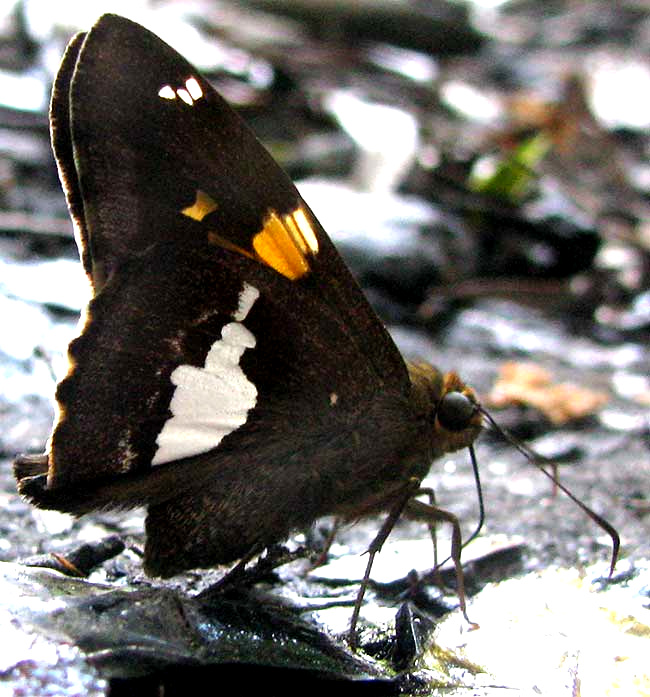Excerpts from Jim Conrad's
Naturalist Newsletter

from the May 13, 2012 Newsletter issued from the woods of the Loess Hill Region a few miles east of Natchez, Mississippi, USA
SILVER-SPOTTED SKIPPER
Not long after an afternoon shower a Silver-spotted Skipper, EPARGYREUS CLARUS, alighted on a spot where earlier some pickle juice had been poured out. You can see the little being supping above.
This is a good skipper to know because he's so common throughout most of the continental US except for the arid regions, frequents human environments, and often lets humans come close for a good look. During our 2006 summer in Kentucky he was the species always bouncing against the inside of the old house's windows, finding it easy to enter but hard to get out. Their caterpillars shelter in folded-over, silked-together leaves.
from the July 13, 2003 Newsletter issued from the woods of the Loess Hill Region a few miles east of Natchez, Mississippi, USA
SILVER-SPOTTED SKIPPERS
The most common butterfly around here at the moment is the Silver-spotted Skipper, EPARGYREUS CLARUS. One reason for their abundance is that the recent rains have caused the Brazilian Vervains I told you about in the June 22 Newsletter to flower like crazy, and the skippers love those flowers. Also, my gardens are heavily mulched with dried pig-manure and hay cleaned from the barn, and the skippers spend a lot of time there enjoying the deliquescing pig turds.
I can't sit down without a Silver-spotted Skipper landing on my sweating body and ticklingly imbibing my sweat. If one lands on a spot of my body not adequately wet, it curls its abdomen beneath it and with its rear end deposits a droplet onto my skin, then with its straw-like proboscis sucks the droplet back up. I'm sure the sucked-up droplet contains the salts it wants from my evaporated sweat.
You may have seen the leaf shelters this species' caterpillars make. The caterpillar bends a leaf corner over to form an open-ended cylinder, then secures the corner in place with silk.
The most interesting part of the caterpillar's behavior comes later, however. It's been shown that a caterpillar's enemies are attracted to it by noticing its accumulated feces. Silver-spotted Skipper caterpillars solve this problem by firing their fecal pellets a distance of up to 40 times their body length away from their leaf shelters, at a speed of 4.2 feet (1.3 meters) per second. The equivalent distance for a 6-foot-tall (1.8 meter) human would be around 240 feet (73 meters).
For you Scrabble players, the word for this form of feces distribution is "scatapulting."